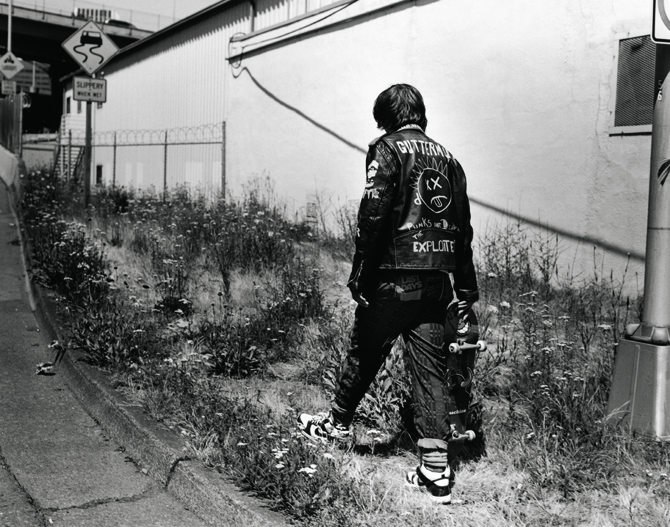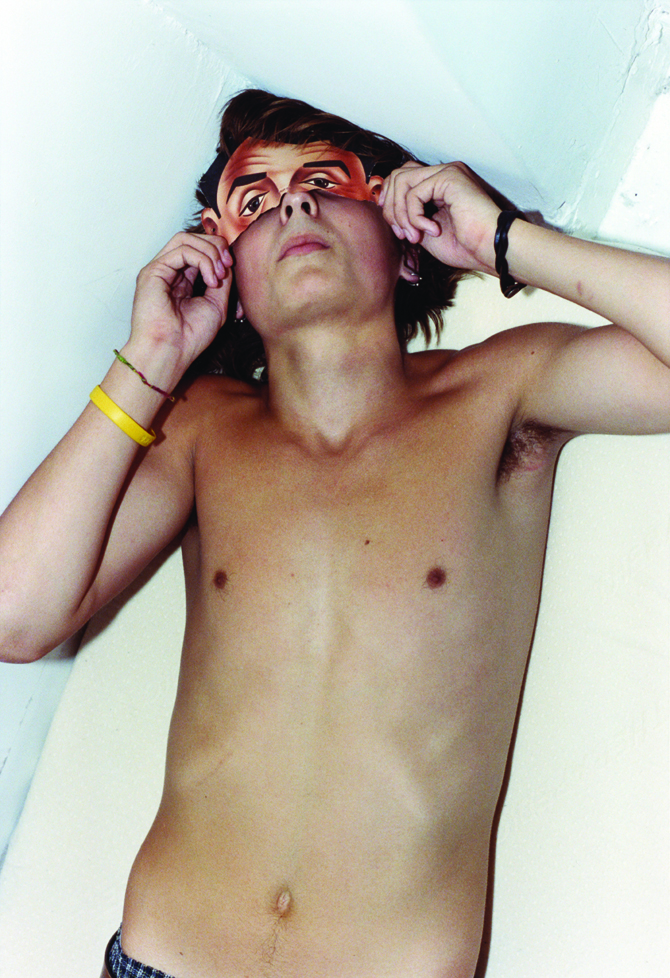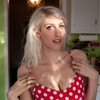You know that feeling you get when you’re so infatuated with someone that you could literally puke, and the only way to accurately express your megafeelings would be to cut the person open and live inside their ribcage? Well, Nick Haymes’s book, Gabe, is the visual representation of that.Some background info:In 2007, a 14-year-old Gabe Nevins auditioned for the part of an extra in Gus Van Sant’s film Paranoid Park. A baby-faced skateboarder from Oregon, Van Sant was so enamored with Gabe that he impulsively cast him in the film’s lead role, playing a skateboarder who accidentally kills a security guard. Soon after the film wrapped, Gabe met photographer Nick Haymes on an editorial shoot. Haymes, like Van Sant, instantly felt there was something special about Gabe (his long flowing locks and girlish features were clearly a powerful combo), and what was supposed to be an afternoon photoshoot turned into four years of obsessive documentation of Gabe’s life.
Haymes has made his career intimately documenting the lives of teenage misfits and skateboarders. Gabe, his third photo book, tells the unexpectedly tragic story of Gabe Nevin’s teen years. What begins as sensuous portraits of an innocent young star turns dark as we watch Gabe struggle with drug abuse, suffer an emotional breakdown, and eventually become homeless. The book is sad and sexy and weirdly romantic all at the same time—a devastating love affair that blurs the line between artist and subject, and makes you feel like a creepy voyeur in the best way possible.
Advertisement

VICE: After meeting Gabe on the editorial shoot, what made you want to keep photographing him?
Nick Haymes: There was just something about him that was a bit off… or dark. I couldn't pin him down in just one picture. When I’m really intrigued by someone I don't like to photograph them for just a day or a week—I want to find out more. Also, he lived in Oregon at the time and, being English, I always find it fun to travel America. I wanted to go and see what sort of life he had out there. So the whole thing started off pretty naive. I never knew the end result, but then, how could I? Right, you could never predict Gabe’s future. But that was my main question—when Gabe’s life began to take darker turns, was there ever a point where you felt a moral obligation to stop taking pictures?
Yeah, I always struggle with it morally. But he liked being photographed, and he had done some acting and thought of it as being in a role. He has an exhibitionist quality, and I've always admired him for his freedom. But I was having moral issues again the other day, especially now that the book is launching and unfortunately he can’t be here. Why not?
I don’t want to say exactly, but he's going through a weird time in his life. When I first looked at the book, not knowing much about you personally, I thought that maybe you and Gabe were in a sexual relationship. You can just sense an intense energy between you two in the photographs, and you capture such intimate moments, like him in the shower, or the photo of him in bed with another guy.
I know what you mean. I did become obsessed with him in some sort of manner, and I think you can have a loving relationship with a man you don’t want to sleep with. If you’re going to photograph someone for four years, you have to be in love with them; there has to be something that keeps you coming back. The relationship was quite weird—it was a friendship, but he didn't have a father, so there was also a sort of father-son thing at points. I think people can really relate to those obsessive feelings. Like when you're in love with someone, and every little thing they do and every square inch of their body seems so profound. That photo in the book of just Gabe’s nipple really nails that obsessive feeling for me.
Yeah, you have to really fall for a person in every way possible. One thing that’s amazing about photographs is how fantastically they can express those feelings.
Nick Haymes: There was just something about him that was a bit off… or dark. I couldn't pin him down in just one picture. When I’m really intrigued by someone I don't like to photograph them for just a day or a week—I want to find out more. Also, he lived in Oregon at the time and, being English, I always find it fun to travel America. I wanted to go and see what sort of life he had out there. So the whole thing started off pretty naive. I never knew the end result, but then, how could I? Right, you could never predict Gabe’s future. But that was my main question—when Gabe’s life began to take darker turns, was there ever a point where you felt a moral obligation to stop taking pictures?
Yeah, I always struggle with it morally. But he liked being photographed, and he had done some acting and thought of it as being in a role. He has an exhibitionist quality, and I've always admired him for his freedom. But I was having moral issues again the other day, especially now that the book is launching and unfortunately he can’t be here. Why not?
I don’t want to say exactly, but he's going through a weird time in his life. When I first looked at the book, not knowing much about you personally, I thought that maybe you and Gabe were in a sexual relationship. You can just sense an intense energy between you two in the photographs, and you capture such intimate moments, like him in the shower, or the photo of him in bed with another guy.
I know what you mean. I did become obsessed with him in some sort of manner, and I think you can have a loving relationship with a man you don’t want to sleep with. If you’re going to photograph someone for four years, you have to be in love with them; there has to be something that keeps you coming back. The relationship was quite weird—it was a friendship, but he didn't have a father, so there was also a sort of father-son thing at points. I think people can really relate to those obsessive feelings. Like when you're in love with someone, and every little thing they do and every square inch of their body seems so profound. That photo in the book of just Gabe’s nipple really nails that obsessive feeling for me.
Yeah, you have to really fall for a person in every way possible. One thing that’s amazing about photographs is how fantastically they can express those feelings.
Advertisement


At one point while you were photographing Gabe he became homeless, right?
Yeah. I was sort of unaware, because our contact dipped in and out for a while. I was always trying to keep in contact by sending him money or a cell phone or something, and then suddenly whenever I talked to him on the phone he’d tell me all these stories about his life on the streets in LA, but I thought he was making them up. All of it sounded like fabrication from an actor. But then I went to visit him and he took me around Hollywood Boulevard, and showed me where he lived and slept, and he knew everyone out there on the streets who were also homeless. And then I thought, “Oh, fuck…” I was a bit shell-shocked. Yeah, the physical changes he goes through in the book are pretty intense. At a point he suddenly has what look like red welts covering his entire body.
Those are from psoriasis. He always had little patches on him whenever we would do pictures, even at the beginning, but when he ran away from home it got way worse. I think it was related to the stress of being on the streets. I remember he was constantly washing himself, or getting himself into water, almost to the point of OCD. It was just burning him so much. Before Gabe you released the book Zoloto, which was photographs of your two sons. There has been some mild controversy about them being naked in some of the photos.
Yeah… I was exhibiting those photos last year, and the gallery didn't want to put them up because the walls were made of hardwood paneling, and they were like, "It's a bit porno." But the images are of my kids, and they don't have anything to do with sex, but straight away people associate nudity with pornography. It's a shame that it's gotten to this point.
Yeah. I was sort of unaware, because our contact dipped in and out for a while. I was always trying to keep in contact by sending him money or a cell phone or something, and then suddenly whenever I talked to him on the phone he’d tell me all these stories about his life on the streets in LA, but I thought he was making them up. All of it sounded like fabrication from an actor. But then I went to visit him and he took me around Hollywood Boulevard, and showed me where he lived and slept, and he knew everyone out there on the streets who were also homeless. And then I thought, “Oh, fuck…” I was a bit shell-shocked. Yeah, the physical changes he goes through in the book are pretty intense. At a point he suddenly has what look like red welts covering his entire body.
Those are from psoriasis. He always had little patches on him whenever we would do pictures, even at the beginning, but when he ran away from home it got way worse. I think it was related to the stress of being on the streets. I remember he was constantly washing himself, or getting himself into water, almost to the point of OCD. It was just burning him so much. Before Gabe you released the book Zoloto, which was photographs of your two sons. There has been some mild controversy about them being naked in some of the photos.
Yeah… I was exhibiting those photos last year, and the gallery didn't want to put them up because the walls were made of hardwood paneling, and they were like, "It's a bit porno." But the images are of my kids, and they don't have anything to do with sex, but straight away people associate nudity with pornography. It's a shame that it's gotten to this point.
Advertisement


Yesterday, I was just re-watching those Calvin Klein TV ads from the 90s where people are being interviewed in front of hardwood paneling—do you remember those? They had this eerie sexiness to them, and they were SO amazing.
Yes, and they got banned straight away. It was the best marketing campaign Calvin Klein ever had. Right, they were banned, but they would never have made it onto TV today. Times have changed.
Yeah, everything is so safe now, so sterile, so conservative. For example, my mother hates the way I photograph the children. Is she religious?
Not really, she's just British. She thinks it's wrong and that the wrong people are going to be looking at them. I said, "Well, it's a photo book, so the people who will be looking at it are people who are into art.” I was trying to make the distinction between art and porn. She said she didn't want the book in her house. For you, why is the nudity in the photographs of your children important?
Well, my kids always run around naked in the house. I’ve always wanted my kids to be really comfortable with nudity, and not to have any shame about their bodies. It’s only when you tell a kid “no” that something becomes taboo, and I don’t think there’s anything wrong with being naked—the whole family does it in the house. I’m a photographer, I take pictures every day, so I think if that’s how my kids behave naturally then I shouldn't hide it. Your first book, Between Dog and Wolf, intimately documents the lives of a group of teen skateboarders. How did that come about?
Well, they're all non-professional skaters who I just met through friends. I started the project around 2005 when I was kicking around the west coast taking pictures. Then at some point one of them said, "Do you want to come and see where I'm from?” and told me he was from Tulsa, Oklahoma. Well, only one thing came to mind when I thought of Tulsa, and that was Larry Clark, naturally. So I followed him there, and jeez, it was so fucked up. I can only imagine.
The project I’m working on now is actually a continuation of that book. But since I started photographing those skateboarders, two of the kids from the project have died. One of them killed himself by jumping out a window, and one was shot in the back of the head. It was like a drug-related incident. Wow, your subjects seem to have bad luck…
Yeah… I get really sad about it. For I while I was scared that I jinxed everyone I photographed. But I suppose you’re attracted to a certain type of person. It’s not like you’re searching for subjects in the Harvard University cafeteria.
I like outsiders for sure, because I end up relating to them quite a bit. That’s why I like skateboarders—it’s such an outsider culture, and it's cheap to do, so it's very working class. It's not like snowboarding, which is for the wealthy. You can spend 50 bucks and can get a skateboard. They’re misfits, and I like that.
Yes, and they got banned straight away. It was the best marketing campaign Calvin Klein ever had. Right, they were banned, but they would never have made it onto TV today. Times have changed.
Yeah, everything is so safe now, so sterile, so conservative. For example, my mother hates the way I photograph the children. Is she religious?
Not really, she's just British. She thinks it's wrong and that the wrong people are going to be looking at them. I said, "Well, it's a photo book, so the people who will be looking at it are people who are into art.” I was trying to make the distinction between art and porn. She said she didn't want the book in her house. For you, why is the nudity in the photographs of your children important?
Well, my kids always run around naked in the house. I’ve always wanted my kids to be really comfortable with nudity, and not to have any shame about their bodies. It’s only when you tell a kid “no” that something becomes taboo, and I don’t think there’s anything wrong with being naked—the whole family does it in the house. I’m a photographer, I take pictures every day, so I think if that’s how my kids behave naturally then I shouldn't hide it. Your first book, Between Dog and Wolf, intimately documents the lives of a group of teen skateboarders. How did that come about?
Well, they're all non-professional skaters who I just met through friends. I started the project around 2005 when I was kicking around the west coast taking pictures. Then at some point one of them said, "Do you want to come and see where I'm from?” and told me he was from Tulsa, Oklahoma. Well, only one thing came to mind when I thought of Tulsa, and that was Larry Clark, naturally. So I followed him there, and jeez, it was so fucked up. I can only imagine.
The project I’m working on now is actually a continuation of that book. But since I started photographing those skateboarders, two of the kids from the project have died. One of them killed himself by jumping out a window, and one was shot in the back of the head. It was like a drug-related incident. Wow, your subjects seem to have bad luck…
Yeah… I get really sad about it. For I while I was scared that I jinxed everyone I photographed. But I suppose you’re attracted to a certain type of person. It’s not like you’re searching for subjects in the Harvard University cafeteria.
I like outsiders for sure, because I end up relating to them quite a bit. That’s why I like skateboarders—it’s such an outsider culture, and it's cheap to do, so it's very working class. It's not like snowboarding, which is for the wealthy. You can spend 50 bucks and can get a skateboard. They’re misfits, and I like that.
Advertisement
GABE was recently published by Damiani Editore and it's distributed in the United States by Artbook.com.On Thursday, March 22nd, at Family Bookstore in Los Angeles from 6:00 to 8:00 PM, Nick will sign copies of GABE.
